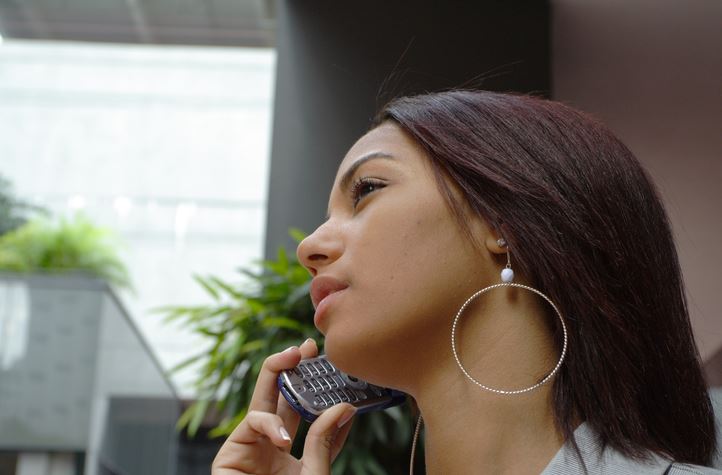Hoop earrings are at the center of a heated debate at a Southern California college.
Pitzer College received a lot of attention last week after a group of Latino students painted "White Girl, Take OFF Your Hoops." on an art wall dedicated to free speech on the side of a dormitory.
Alegria Martinez, a campus Resident Advisor (RA) and active member of the "Latinx Student Union", claimed responsibility for the painting along with several other students in an email thread sent to the entire student body, according to the Claremont Independent, the student paper for Claremont colleges.
In the email, Martinez said she and other women of color were "tired and annoyed" with "white women appropriating styles that belong to the black and brown folks who created the culture".
"The culture actually comes from a historical background of oppression and exclusion." Martinez said in the email. "The black and brown bodies who typically wear hooped earrings, (and other accessories like winged eyeliner, gold name plate necklaces, etc) are typically viewed as ghetto, and are not taken seriously by others in their daily lives."
The RA claimed white people exploited the culture and "made it into fashion".
The painting prompted threats and hate speech from people outside the campus. College President Melvin L. Oliver responded to the threats in an open letter to the student community condemning violent speech directed at the Latino students.
So what is the origin of the hoop earring?
There is no pinpointing who was the first to rock a pair of hoop earrings, but the popular jewelry piece can be traced back to Ashurnasirpal II, King of Assyria (884-859 BCE), according to the Cultural Encyclopedia of the Body.
There is a depiction of the king wearing thick hoop earrings in a palace in the ancient city of Nimrud, which is modern day Iraq.
Hoop earrings were evident in the major cultures of the ancient world including with the Greeks and Romans.
Pirates and sailors also often wore gold hoop earrings. Seaman often wore the earrings as a mark of their travels, according to LiveScience.
Pirates also used hoop earrings for superstitious reasons since it was believed the metals in an earring contained magic healing powers. Others believed the earrings would keep them from drowning or sea sickness.
When a seaman died, the earring would pay for their funerals or to pay for their bodies to go back home. Pirates would even dangle wax from their earring to use as ear plugs for when firing cannons.
Why do some women of color have a cultural connection to hoop earrings?
In more modern times, hoop earrings were often associated with the "Chola" subculture, a rebel Latino lifestyle that emerged in the 1980s and early 1990s.
The Chola "look" was first seen in working class Mexican neighborhoods in Southern California where Latin women dealt with gang warfare, violence and poverty. Chola women wore penciled-in thin eyebrows, thick winged eyeliner, darkly lined lips and teased their hair with Aquanet hairspray. They'd accessorize with hoop earrings, nameplate necklaces and baggy shirts.
The fashion was the result of impoverished women in "barrios" making a lot out of the little things they could afford, according to the 2015 VICE article, The Folk Feminist Struggle Behind the Chola Fashion Trend.
The door-knocker earrings were part of a look that came with a tough attitude and lifestyle.
Young Latinas usually receive their first pair of small hoop earring from the time they're born, according to Lorena Marquez, an assistant professor for the Department of Chicana/o Studies at UC Davis.
"I know that in Mexico infants girls get their first set of hoop earrings or arracadas." Marquez said in an email. "The reason for hoop earrings is that they don't have a back to them and therefore little girls won't lose them. I don't know how far back this goes, but my guess is that perhaps the Spanish brought this with them. You can often see old portraits of infant girls wearing arracadas or earrings."
Hoop earrings are still a symbol of Latina culture and worn to this day as a form of fashion and cultural resistance.
In black communities, bamboo earrings, which are large hoop earrings shaped like bamboo, have a similar significance to women as in the Latino community.
Just like in the working class Latino neighborhoods, bamboo earrings are often seen as a symbol of struggle in poorer black communities. The earrings are often found for less than three dollars at beauty stores or small shops and many in the community consider the earrings to be a part of black women's culture.
In 2016, when Urban Outfitters started selling the bamboo earrings for $16 at their trendy stores, the product was received with online backlash. Many were outraged over the inflated price of a typically inexpensive product and called out the retail store for cultural appropriation and the rebranding of the earrings.
There's no doubt hoop earrings are a powerful symbol for various cultures. However, it's important to acknowledge, the fashion statement has been worn by both men and women since ancient times and will likely continue to be worn by many other cultures to come.


